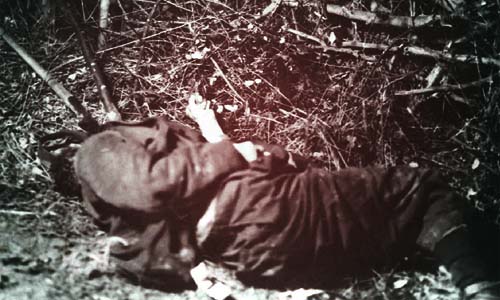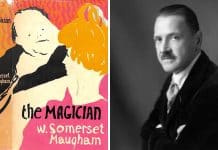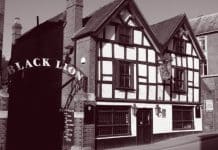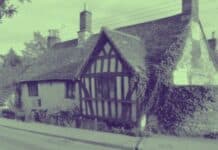Lower Quinton Witchcraft Murder: Was witchcraft behind the grisly murder of Charles Walton on a Warwickshire hill back in 1945? Guest writer CLAIRE ATKINSON looks back on the sensational unsolved crime.
On Valentines Day 1945, Charles Walton left his home in Lower Quinton in Warwickshire to go and tend a fence on the slopes of Meon Hill. Waved off by his niece Edith, Charles made his way to work, with his walking stick, his pitchfork and billhook in hand, never to return.
Edith raised the alarm at 6pm, when she returned home from work to an empty house, after a brief search, they found him on Meon Hill.
His body was pinned to the ground by his pitchfork, the prongs passing through each side of his neck. Deep gashes made by his billhook in the shape of a cross, on his throat and chest, with the murder weapon still embedded in one of the wounds. His arms were covered in defensive wounds as he tried to fend of his attacker.
A police investigation led by Detective Superintendent Robert Fabian, who was the most famous police officer of his day from Scotland Yard, took over the local inquiry when the hunt for the killer hit national headlines. After several lines of enquiry fell short, a local Detective Alec Spooner, who had been following his own research, hinted at a link to witchcraft.
Through Spooner, Fabian learned that an eerily similar murder had occurred in the nearby village in 1875. Anne Tennant had been killed with a pitchfork by a man named John Haywood. In his confession, that had been recorded in the book Warwickshire (1906) by Clive Holland. Haywood promised “that he would kill all the witches in Long Compton, and that there were sixteen of them.”
In addition, according to local folklore, in 1885, on nine successive evenings a boy encountered a black dog – a witchcraft symbol – on Meon Hill. On the last occasion the dog turned into a headless woman who rustled past him in a black dress. Next day the boy’s sister died. The boy’s name was Charles Walton.
It is claimed that, soon after Walton’s murder, a black dog was found hanging from a tree close to the murder scene, while Fabian himself wrote that he encountered a black dog while walking at dusk on Meon Hill. He claimed the dog had run past him and shortly afterwards he met a local boy walking in the same direction. He asked the boy if he was looking for his dog, but when Fabian mentioned the animal’s colour, the boy turned a deathly pale and fled in the opposite direction.
Charles Walton’s watch found by workmen demolishing outhouses
In August 1960, during the demolition of outhouses behind Charles Walton’s cottage, workmen found an old tin pocket watch. It was later identified as being the watch that Walton was wearing on the day of his death. Inside of the watch case, a small piece of coloured glass was found. Walton was known to have carried this around with him, never letting it out of his possession. Known as a piece of witch glass, it is used to either reflect or absorb any evil thoughts that had been directed at its owner.
Some 25 years later, Fabien would write in his book “The anatomy of crime”:
I advise anybody who is tempted at any time to venture into Black Magic, witchcraft, Shamanism – call it what you will – to remember Charles Walton and to think of his death, which was clearly the ghastly climax of a pagan rite. There is no stronger argument for keeping as far away as possible from the villains with their swords, incense and mumbo-jumbo. It is prudence on which your future peace of mind and even your life could depend.
The Cotswolds and Meon Hill are said to be steeped in witchcraft and Wicca; even to this day campfires can be seen burning on the hill at the solstice and Halloween.
Watch Lower Quinton Witchcraft Murder video
Guest writer CLAIRE ATKINSON is a web developer by day, a graphic designer by night and has a lifetime fascination on anything spooky.









Where do I start? You conjecture that this was part of a pagan rite is based on bias and not fact. That you push bastardised Christain beliefs and many other wildly different religious groups together shows your utter disregaurd for facts. All likelyhood the victim was murdered by a Christian rather than a pagan, witch or otherwise.
Ritualised killing of people is most often linked to serial killers. Their need for person trophies, to draw out the death experience because they gain pleasure from it, their modus operandum, can be like others but is purely unique.
While the death of this man was tragic, this piece is far more about the prejudices and ignorance of the police and your good self than the “evil” ways of people who practice faiths based on ideas like kindness, community, knowledge and the Divinty of all life.
Sword waving and incense aside, the murderer got away with killing a man because of EXACTLY this narrow-minded thinking. Ignorance of evidence, or fact, people persecute those they fear.
Do you know how many people were murdered for being a witch THIS year alone? With no evidence, or proof? With very little push to punish or catch these people? All because people LIKE YOU, push a message of fear, hate and stupidity.
Lucy, I agree with your sentiments. However, where in the article did the author say they, themselves, believed it was a “pagan rite”?
Is this the part you are referring to:
“I advise anybody who is tempted at any time to venture into Black Magic, witchcraft, Shamanism – call it what you will – to remember Charles Walton and to think of his death, which was clearly the ghastly climax of a pagan rite. There is no stronger argument for keeping as far away as possible from the villains with their swords, incense and mumbo-jumbo. It is prudence on which your future peace of mind and even your life could depend”.
The author was quoting Detective Fabien and his assumptions/theories in his book, ” The Anatomy of Crime”. Those above words are not from the author of the article, but from the detective. Unless, I am confused, and you are speaking of something else?
Interesting article, although after undertaking some preliminary research on this case myself I completely agree with Lucy’s sentiments (in Comments, above)
We’ll probably never know who murdered Charles Walton, but the fact his death was orchestrated to look like it was a ‘witchcraft killing’ only underlines that a true Witch almost certainly wasn’t responsible. In fact, if Charles Walton did practice witchcraft as most reports suggest (and local people believed) a Witch was the victim of this crime, not a perpetrator.
Certainly, the murderer must have had some rudimentary knowledge of the craft to convincingly stage such a ritual killing, and – maybe – he/she was someone who dabbled in the Black Arts and used them in a vendetta against Charles Walton, but this murder only underlines how Witch persecution is still tragically alive and well in our supposedly modern world, and (as Lucy says), the tone of the article – as well written as it is – does nothing to address that.
I’m a writer / actor who’s just been asked to write a book about ‘Witchcraft and Black Magic in British Horror Cinema’ for a UK publisher. My aim, when discussing those movies, is also to separate fact from fiction and hopefully educate readers in the differences between fairytale / movie witchcraft and the real thing.
When this book is completed, I’m hoping to begin work on a second book purely about Witch Persecution in the present day, exposing the awful prejudices and violence that modern Witches continue to face.
If anyone has any information or personal experiences they’d be willing to share with me (including Lucy), I’d be extremely grateful for the input. I am not a Witch myself but I hope it’s apparent through this message that I’ve had a lifelong interest in the Craft, an empathy and respect for those who practice it, and the more I read about instances like the Charles Walton ‘witchcraft murder’ the more I want to redress the balance, defend the Witch, and expose the reality for what it is.
My email: danmunrolondon@hotmail.co.uk
Many thanks